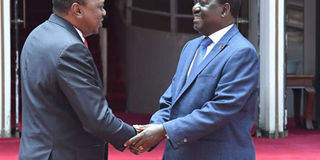Revisit Kenyatta-Odinga pact to guide reforms

President Uhuru Kenyatta (left) and ODM leader Raila Odinga strike a truce deal at Harambee House on March 9, 2018. PHOTO | FILE | NATION MEDIA GROUP
What you need to know:
- In many ways, Kenya’s political culture was structurally unbalanced right from independence when the colonial authorities shaped politics strictly along ethnic lines.
- Corruption, public safety and security, ensuring shared prosperity and safeguarding every Kenyan’s rights while ensuring they meet their responsibilities are other subjects flagged.
The debate over what type of reforms should flow from the now-famous “handshake” between President Uhuru Kenyatta and ODM leader Raila Odinga is likely to be the defining feature of Kenyan politics in 2019.
At the heart of this discussion is the substantive issue of what changes to the 2010 Constitution are needed to make politics in the country a less existential affair and to ensure elections are not a cyclical threat to lives and livelihoods.
Linked to this, of course, is the counter-proposition that what needs to change in Kenya is the culture of the political class and that, fundamentally, there is little that is wrong with the supreme law of the land.
In the last few weeks, a consensus seems to have emerged among rival politicians that, in fact, some changes should be implemented.
What is unclear is how these should be arrived at and what they should aim to address.
GUIDELINES
The Building Bridges Initiative, a task force which was mandated to collate and synthesise the views of Kenyans on this, has been going around the country collecting memoranda and proposals on the way forward.
Through all this, however, there has been surprisingly little discussion about the very substantive and voluminous report which President Kenyatta and Mr Odinga released to the country on the steps of Harambee House on March 9.
It is understandable that the political “earthquake” which the handshake represented — a very rare and commendable decision by two powerful politicians to bring the country together after a bruising election — should have captured the headlines and the public imagination for a long time.
But the details of that striking eight-page document should clearly be revisited and can serve as an excellent guide to the country on the way forward.
Rarely have two leaders offered such a detailed, candid and even self-critical examination of the problems that the country confronts.
STABILITY
Kenyatta and Odinga, two scions of the nation’s founding fathers, admitted in that document that Kenya has failed to meet its promise and they faced up to the fact that, if this generation does not rise to the challenge of changing course, the country is likely to endure “the same kind of calamities we have experienced in the past”.
The document goes on at length to discuss many of the questions which are animating debate on the way forward today.
It homes in on a number of specific issues which Kenya needs to address to achieve long-term stability.
These issues are not new. Yet the road map suggested by the Kenyatta-Odinga document deserves closer examination.
One of the first points raised is that of ethnic antagonism and competition.
In many ways, Kenya’s political culture was structurally unbalanced right from independence when the colonial authorities shaped politics strictly along ethnic lines.
That has not changed nearly six decades after independence — and the political class takes the blame for this.
DEVOLUTION
What modalities can be adopted to change this? This is a pivotal issue that should be divorced from the short-term ambitions of players on the political scene.
Related to this is the issue of a lack of national ethos that has seen a breakdown in governance, including violent descent into disorder every time elections come around, which has come to define perceptions of Kenya on the international scene.
The third subject identified in the building bridges document is that of inclusivity which is, of course, integral to the question of how the nation can deepen national cohesion to address the first two issues.
Devolution is rightly identified as one of the greatest successes of the 2010 Constitution.
A key question raised is that of deepening it and making it politically sustainable. This is linked to the viability of the current model.
VIOLENCE
Corruption, public safety and security, ensuring shared prosperity and safeguarding every Kenyan’s rights while ensuring they meet their responsibilities are other subjects flagged.
This is not intended to be an exhaustive analysis of that document.
However, political scientists, political parties, the private sector, civil society, religious leaders, the media and members of the public — who all have a stake in how the reform process should unfold — all have a responsibility to re-examine this expansive document and consider how its provisions can chart a way forward.
Both Kenyatta and Odinga have repeatedly said that they see bringing the country together and ending cycles of antagonism around election time as one of the pivotal elements they hope will be their collective legacy.
The building bridges task force is the vehicle designed to listen to Kenyans and outline the policy, administrative reform proposals, and implementation modalities for each identified challenge area.
A good starting point should be for them to disseminate this document more widely and to invite public discussion of a charter that can guide the nation.
Dr Bagaka is a governance and public policy consultant. [email protected]




